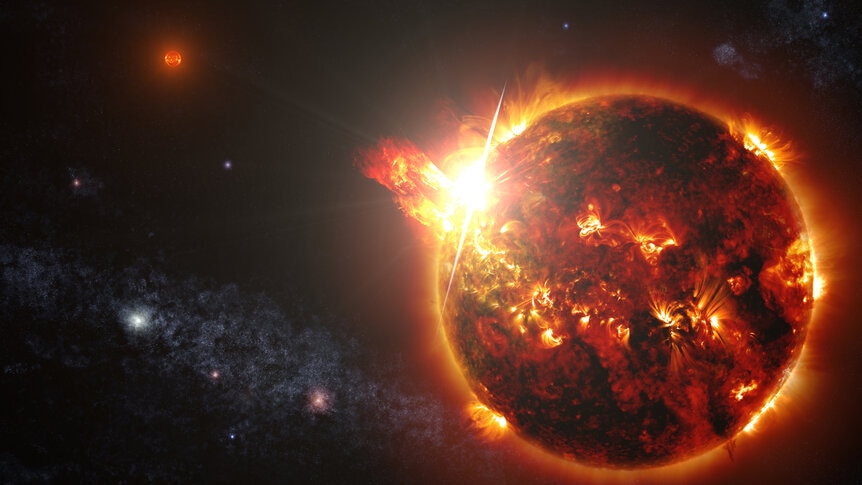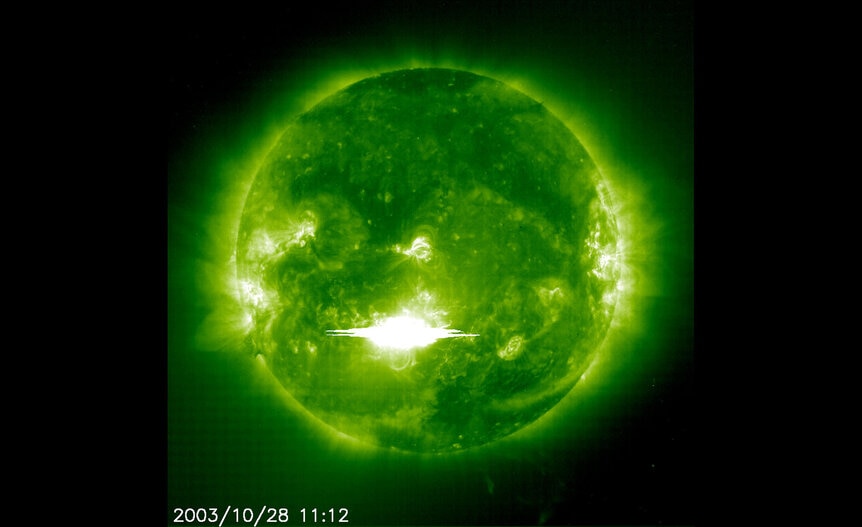Create a free profile to get unlimited access to exclusive videos, sweepstakes, and more!
Planets around old red dwarfs may still get blowtorched by flares

Well, this news is a bit of a bummer: Planets that orbit even really old red dwarfs can still get viciously zapped by high-energy radiation from flares, making it difficult for them to support life. It's not so much the flares kill everything they touch, it's that over the lifetime of the planet they strip the atmosphere away.
As you can imagine, that makes breathing difficult.
The new study only looked at a single star, but it's a telling one: Barnard's star, a red dwarf just 6 light years away. It's actually the fourth closest known star to the Sun (bearing in mind the Alpha Centauri system is a triple star, so that one group is 1 through 3). That's why it was picked for the study, because its proximity makes it easier to study.
Red dwarfs have less mass than the Sun, are cooler, and fainter. Specifically, Barnard's Star has only 1/6th the Sun's mass, 1/5th its diameter, and shines at an incredibly feeble 1/300th the Sun's brightness. If the Earth orbited Barnard's star at the same distance it does from the Sun, it would freeze solid.
Also, Barnard's star is old, about 10 billion years old. That's twice as old as the Sun. That plays a big role here.
Despite their diminutive size, red dwarfs can be explosively violent. They can emit powerful stellar flares, which are enormous explosions of energy from their surfaces. Flares occur when the magnetic field lines created inside a star tangle up near the surface. These lines store huge amounts of energy, and if the lines snap — essentially short circuiting — that energy gets released all at once.
The magnetic fields of stars are created due to two things: rising and falling parcels of plasma (ionized gas) inside them, and their rotation. The rotation of the star acts as a dynamo, generating the magnetic field. The plasma deep in the star is hot, so it rises, and when it hits the surface it cools and falls again (this is called buoyant convection). The magnetic field inside these parcels of plasma is what can cause flares when they reach the surface.
Although red dwarfs can be very dim, they are fully convective, meaning plasma starts rising from the core itself all the way to the surface. That gives them a lot of time to generate powerful magnetic fields.
When stars are young they tend to spin rapidly. They slow with age, mostly as they blow a wind of particles from their surface (like the Sun's solar wind). As the star spins, its magnetic field spins with it, catching the subatomic particles like a fishing net cast into water. This causes drag, slowing the star's spin. Over millions and even billions of years, a star's spin can slow quite a bit. Since the spin helps generate the energy to power the magnetic field, older stars tend to have weaker magnetism… which in turn means they don't flare as much.
Very young red dwarfs are terrifying; they erupt with gigantic flares all the time, making them terrible places to look for planets with life. First of all, these flares are ridiculously powerful, sometimes equaling the total amount of energy the star puts out otherwise. Also, they emit tons of hard high-energy radiation like ultraviolet and X-rays.
But as they age they settle down, right? And given that Barnard's Star is so ancient, it must be pretty calm. Right? Right?
Yeah, in this case not so much. The new study used Hubble and Chandra to examine the nearby dim bulb to see how often it flares and how powerful they are. Although they didn't observe it for long (about 14 hours total) Barnard's Star performed for them pretty well: It erupted three times, twice in the far-ultraviolet and once in X-rays. Looking at the overall duration times of the flares, the astronomers found that Barnard's Star is in a flare state about 25% of the time.
That's a lot. Like, a lot a lot. The flares weren't super powerful — about one ten-thousandth as bright as the total energy of the Sun — but still a big deal. Why?
We know that red dwarfs are good at making planets like Earth (roughly the same size and made of the same sort of material). To be habitable around such a feeble star, though, these potential Earths have to orbit close in. That means when the star flares, the planet takes the full brunt of it.
The atmosphere absorbs that energy, but doing so heats it up, making it puffier, and more likely to leak away from the planet. The astronomers calculate that a planet like Earth orbiting Barnard's Star would lose its atmosphere in roughly 10 million years.
Holy yikes. That's fast.
Mind you, any planet like Earth that close to its red dwarf host would probably lose its air rapidly after it formed, because, remember, the stars flare a whole lot more when they're young. The hope was that after the star settles down, geological processes might create a second atmosphere around the planet, making it potentially habitable.
This new study shows that's unlikely. Like I said earlier: Bummer.
Well, maybe. Again, this is one star, chosen because it was close, so the flares could be detected more easily. It's possible Barnard's Star is unusually flarey for an old red dwarf.
After all, not all red dwarfs are this active. In fact, in another paper just published astronomers found a couple of warm planets orbiting two different red dwarfs, and both stars appear inactive as far as flares go. The planets are larger than Earth and receive quite a bit more heat from their stars that we do (one gets more than Venus, the other more than Mercury!), but still, this gives me hope that there are yet many Earth-sized planets orbiting calmer red dwarfs out there.
This won't help Barnard's Star's planet, though. Not long ago a planet was found orbiting Barnard's Star, a super-Earth, though far enough out (60 million kilometers) that it's almost certainly incredibly cold, roughly -170°C! In that case, getting hit by billions of flares might be doing it a service.
I'll note as I always do that we're still getting started understanding all this, and there's a long way to go. Maybe there are billions of Earth-sized planets in the galaxy stripped bare by their tantrum-throwing host stars, or maybe there are mitigating factors we don't know yet.
That latter may be the way to bet, so I'm not quite ready to throw out a whole galaxy over one star. Let's keep looking.






























